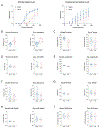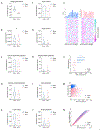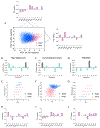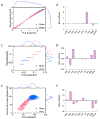Single Neuron Modeling Identifies Potassium Channel Modulation as Potential Target for Repetitive Head Impacts
- PMID: 37294503
- PMCID: PMC10833395
- DOI: 10.1007/s12021-023-09633-7
Single Neuron Modeling Identifies Potassium Channel Modulation as Potential Target for Repetitive Head Impacts
Abstract
Traumatic brain injury (TBI) and repetitive head impacts can result in a wide range of neurological symptoms. Despite being the most common neurological disorder in the world, repeat head impacts and TBI do not have any FDA-approved treatments. Single neuron modeling allows researchers to extrapolate cellular changes in individual neurons based on experimental data. We recently characterized a model of high frequency head impact (HFHI) with a phenotype of cognitive deficits associated with decreases in neuronal excitability of CA1 neurons and synaptic changes. While the synaptic changes have been interrogated in vivo, the cause and potential therapeutic targets of hypoexcitability following repetitive head impacts are unknown. Here, we generated in silico models of CA1 pyramidal neurons from current clamp data of control mice and mice that sustained HFHI. We use a directed evolution algorithm with a crowding penalty to generate a large and unbiased population of plausible models for each group that approximated the experimental features. The HFHI neuron model population showed decreased voltage gated sodium conductance and a general increase in potassium channel conductance. We used partial least squares regression analysis to identify combinations of channels that may account for CA1 hypoexcitability after HFHI. The hypoexcitability phenotype in models was linked to A- and M-type potassium channels in combination, but not by any single channel correlations. We provide an open access set of CA1 pyramidal neuron models for both control and HFHI conditions that can be used to predict the effects of pharmacological interventions in TBI models.
Keywords: Brain injury–traumatic; Computational modeling; Computational neuroscience; Mouse model; Neuron physiology; Subconcussive head impact.
© 2023. The Author(s), under exclusive licence to Springer Science+Business Media, LLC, part of Springer Nature.
Conflict of interest statement
Statements and Declarations
The authors declare that the research was conducted in the absence of any commercial or financial relationships that could be construed as a potential conflict of interest.
Figures





Similar articles
-
The Black Book of Psychotropic Dosing and Monitoring.Psychopharmacol Bull. 2024 Jul 8;54(3):8-59. Psychopharmacol Bull. 2024. PMID: 38993656 Free PMC article. Review.
-
Drugs for preventing postoperative nausea and vomiting in adults after general anaesthesia: a network meta-analysis.Cochrane Database Syst Rev. 2020 Oct 19;10(10):CD012859. doi: 10.1002/14651858.CD012859.pub2. Cochrane Database Syst Rev. 2020. PMID: 33075160 Free PMC article.
-
Amnesia after Repeated Head Impact Is Caused by Impaired Synaptic Plasticity in the Memory Engram.J Neurosci. 2024 Feb 21;44(8):e1560232024. doi: 10.1523/JNEUROSCI.1560-23.2024. J Neurosci. 2024. PMID: 38228367 Free PMC article.
-
Cost-effectiveness of using prognostic information to select women with breast cancer for adjuvant systemic therapy.Health Technol Assess. 2006 Sep;10(34):iii-iv, ix-xi, 1-204. doi: 10.3310/hta10340. Health Technol Assess. 2006. PMID: 16959170
-
Systemic pharmacological treatments for chronic plaque psoriasis: a network meta-analysis.Cochrane Database Syst Rev. 2021 Apr 19;4(4):CD011535. doi: 10.1002/14651858.CD011535.pub4. Cochrane Database Syst Rev. 2021. Update in: Cochrane Database Syst Rev. 2022 May 23;5:CD011535. doi: 10.1002/14651858.CD011535.pub5. PMID: 33871055 Free PMC article. Updated.
Cited by
-
Power spectral analysis of voltage-gated channels in neurons.Front Neuroinform. 2025 Jan 15;18:1472499. doi: 10.3389/fninf.2024.1472499. eCollection 2024. Front Neuroinform. 2025. PMID: 39882027 Free PMC article.
References
-
- Ascoli GA, Donohue DE, & Halavi M (2007). NeuroMorpho.Org: a central resource for neuronal morphologies. J Neurosci, 27(35), 9247–9251. 10.1523/JNEUROSCI.2055-07.2007 - DOI - PMC - PubMed
-
- Aungst SL, Kabadi SV, Thompson SM, Stoica BA, & Faden AI (2014). Repeated mild traumatic brain injury causes chronic neuroinflammation, changes in hippocampal synaptic plasticity, and associated cognitive deficits. J Cereb Blood Flow Metab, 34(7), 1223–1232. 10.1038/icbfm.2014.75 - DOI - PMC - PubMed
Publication types
MeSH terms
Substances
Grants and funding
LinkOut - more resources
Full Text Sources
Molecular Biology Databases
Miscellaneous

